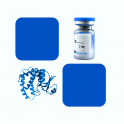
- Remove this product from my favorite's list.
- Add this product to my list of favorites.
Products
Newsletter
 |  |  |  |  |  |

Background
Carcinoembryonic antigen-related cell adhesion molecule 8 (CEACAM8) also known as CD66b (Cluster of Differentiation 66b), CD66b, CD67, CGM6, NCA-95, and is one of seven human CEACAM family members within the immunoglobulin superfamily. CEACAM family members are a set of widely expressed proteins involved in several biological functions, including cell adhesion, migration, signal transduction, and the regulation of gene expression. Abnormal overexpression and downregulation of some CEACAMs have been described in tumor cells. In humans, CEACAMs include type I transmembrane proteins (CEACAM1, CEACAM3, and CEACAM4) and GPI-linked molecules (CEACAM5 through CEACAM8). There is no human CEACAM2. CEACAM8 is a single chain, two Ig-like C2-type (immunoglobulin-like) domains and one Ig-like V-type (immunoglobulin-like) domain. It is an activation marker for human granulocytes.[1-4]
Source
Recombinant Human CEACAM8 /CD66b Protein (rhCEACAM8), His Tag (CE8-H5224) is expressed from human 293 cells (HEK293). It contains AA Gln 35 - Ser 319 (Accession # NP_001807.2).
Predicted N-terminus: Gln 35
Molecular Characterization
This protein carries a polyhistidine tag at the C-terminus.
The protein has a calculated MW of 32.2 kDa. The protein migrates as 53-66 kDa under reducing (R) condition (SDS-PAGE) due to glycosylation.
Endotoxin
Less than 1.0 EU per μg by the LAL method.
Purity
>95% as determined by SDS-PAGE.
Formulation
Lyophilized from 0.22 μm filtered solution in PBS, pH7.4. Normally trehalose is added as protectant before lyophilization.
Reconstitution
See Certificate of Analysis for details of reconstitution instruction and specific concentration.
Storage
For long term storage, the product should be stored at lyophilized state at -20°C or lower.
Please avoid repeated freeze-thaw cycles.
This product is stable after storage at:
-20°C to -70°C for 12 months in lyophilized state;
-70°C for 3 months under sterile conditions after reconstitution.
Bioactivity
Please refer to product data sheet.
(1) "Development of a highly thermostable immunoassay based on a nanobody-alkaline phosphatase fusion protein for carcinoembryonic antigen detection"
Lin, Yu, Wang et al
Anal Bioanal Chem (2020) 412 (8), 1723-1728
(2) "Differentiation and activation of eosinophils in the human bone marrow during experimental human endotoxemia"
Hassani, Leijte, Bruse et al
J Leukoc Biol (2020) 108 (5), 1665-1671
(3) "Neutrophil trafficking on-a-chip: an in vitro, organotypic model for investigating neutrophil priming, extravasation, and migration with spatiotemporal control"
McMinn, Hind, Huttenlocher et al
Lab Chip (2019) 19 (21), 3697-3705
Showing 1-3 of 5 papers.
Follow us